We are what we wear: How sports jerseys became ubiquitous in the U.S.

A green mass of humans encircles Lambeau Field and spreads to the streets, driveways and lawns of neighboring homes, belching tendrils of white breath and black barbecue smoke into the subfreezing Wisconsin air. Vehicles snake through the crowd in a tedious dance toward coveted parking places in the shadow of a colossal stadium that rises from stern flatland toward a gray sky. Postcard snowflakes tumble earthward endlessly. The people are all of us. They are rugged men with long beards and they are women in nighttime makeup. They are old enough to have seen Lombardi alive and young enough to have missed Favre altogether. They are tall and short, slender and fat, sober and drunk.
But many of them share this: A green football jersey. How many of them? It’s impossible to guess with accuracy. Thousands, certainly. Many thousands. Quarterback Aaron Rodgers’s number 12 is everywhere, but only scarcely more so than linebacker Clay Matthews’s number 52 or wide receiver Jordy Nelson’s number 87. Many players are represented, including some who haven’t played recently (Charles Woodson, number 21) or in a very long time (Paul Hornung, number 5), or who have passed away (Max McGee, number 85). There are jerseys in tribute to famous players (Ray Nitschke, number 66) and relatively obscure ones (Don Majkowski, number 7). There are current jerseys, throwback jerseys, cheap jerseys and expensive jerseys.
A scene like this plays out eight times a year in Green Bay. The fans will crate their parties and surge toward entry portals, and they will look very much like a football team, sheathed in their XXXL gamewear models designed for 320-pound men to wear in actual football combat or for far smaller people to wear over five layers of lycra, fleece and down. The scene is almost gladiatorial; just as the players funnel down a narrow tunnel and emerge to the roar of their fans, those same fans push hurriedly into the coliseum in the final moments before kickoff, one with the event, dressed to kill. But understand: This scene is striking not because it is unusual but because it is commonplace.
• MORE: Many San Francisco residents want no part of Super Bowl party
Over the last four decades, American sports fans have transformed themselves from a populace that dresses almost exclusively in civilian clothing and pays to watch athletes perform in uniform, to one that dresses—in significant numbers—exactly like those athletes. This weekend’s Super Bowl will be overrun by fans in XXL Broncos and Panthers jerseys, just like last weekend’s NHL All-Star game was awash in sweaters from teams around the league. Theirs has been a multi-billion dollar metamorphosis that radically altered the appearance of stadiums and arenas across the nation. It is, anecdotally, most pervasive in the NFL and the NHL, marginally less so in Major League Baseball and the NBA (the latter at least in part because of the less utilitarian nature of the basketball top). Jersey-wearing by fans is such normative behavior in the modern sports culture that its absurdity—dressing like players? Really?—has long been snowed under by its ubiquity. “We have reached the point where if you are the one not wearing the jersey, you are the one who stands out,” says Christian End, associate professor of psychology at Xavier, who has studied fan behavior.
But how did we reach this point? And when did it all begin?
*****
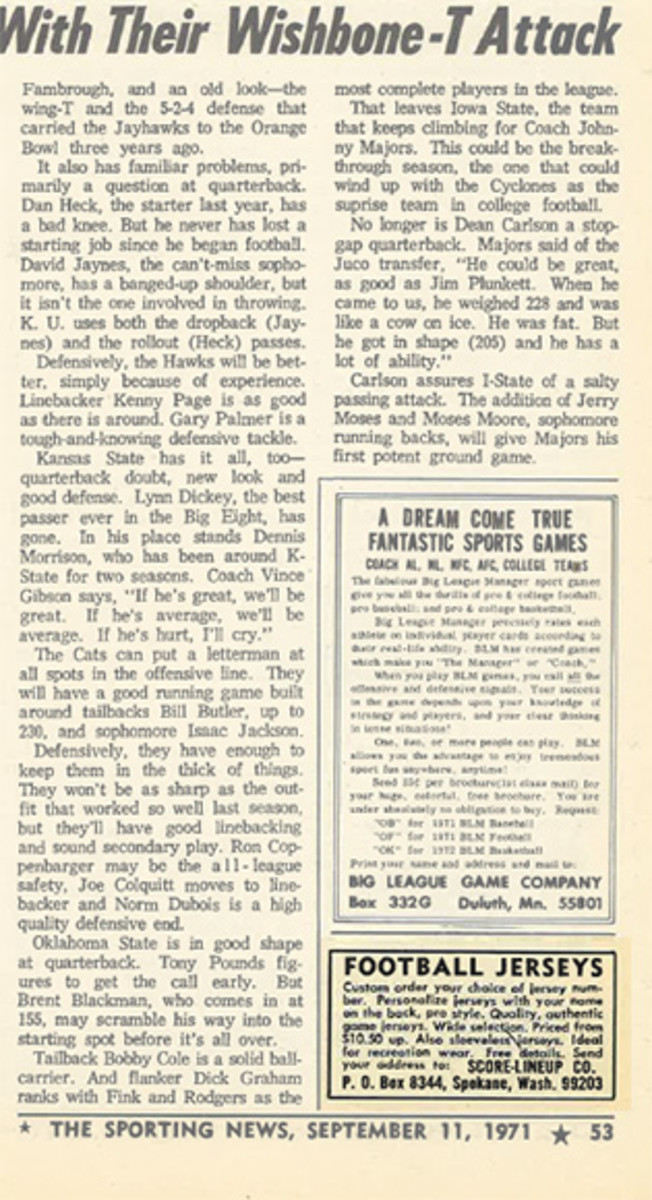
The advertisement was tucked into the bottom corner of The Sporting News, a weekly broadsheet newspaper, established in 1886, that for many years provided the only aggregation of national sports news in a world ruled by local papers. The Sporting News was also an invaluable resource for decidedly oddball services. Buried among these ads in 1971 was a one-by-two-inch display, 52 words under the headline Football Jerseys. It read, in part: Custom order your choice of jersey number, personalize jerseys with your name on the back, pro-style. Priced from $10.50 up ... send your address to: SCORE-LINEUP Co. Spokane, Wash.
In 1971, I was a rising high school sophomore in the part of upstate New York that’s closer to Canada than to New York City. I was a small-town athlete and a nut for all things related to athletics of any kind, not least of all uniforms, and I had already owned a few generic cotton football jerseys, including a white-with-red-numerals number 45 that I envisioned as Homer Jones of the Giants, my father’s favorite NFL team, and thus mine. So it was as if the SCORE-LINEUP Co. of Spokane, Wash., was marketing directly to my soul.
I sent for the company’s catalog and designed my own jersey. I would wear number 18 because my favorite player at any level was Ole Miss quarterback Archie Manning. (I was a quarterback and fancied myself a descendant of Manning’s swashbuckling style, though I was not, in any way). This company didn’t do college designs, so I picked out the colors of the Kansas City Chiefs for no reason that I can recall, and I had my own name put on the back. When the jersey arrived, it was exactly as I had dreamed: red with white and yellow piping on the sleeves and rubbery numerals, along with my last name, steamed onto the material. It could not have looked more authentic to my eyes, and I’m certain I wore it every day for a month. A year later, I ordered a Saints number 8 jersey (Manning’s NFL digit) and a Vikings number 10 (Fran Tarkenton) for my younger brother, plus a Knicks number 10 tank top in honor of Walt Frazier, another of my childhood idols.
Four decades would pass before I found myself circling the concourse at Pittsburgh’s Consol Energy Center with a friend, both of us killing a night on the eve of covering a Steelers playoff game. We were awash in jersey-wearing Penguins fans when I casually mentioned that there might be a story in how this trend came to be so pervasive. Before I made it to my seat that night, I knew that my search would begin with the SCORE-LINEUP Co. of Spokane, Wash. Back home, I bought old issues of The Sporting News on eBay and located that 1971 advertisement, confirming my hazy memory. This became my touchstone: You could buy a replica football (or basketball) jersey in the summer of ’71. My timeline would work forward and backward from there.
This search for the roots of the retail jersey culture—that’s what they’re called in the sporting goods business: “retail jerseys,” designating their purpose as sales items for the public—took me back to a murky, unrecorded past, and to an unregulated, unlicensed Wild West market where success was the province of renegades and hustlers, of the clever and desperate, and where the almighty overlords of the professional sports leagues were slow to recognize the obvious.
My search for genius turned up only opportunism. My search for inspiration turned up only happenstance. It turns out we wear jerseys because we just do.
*****
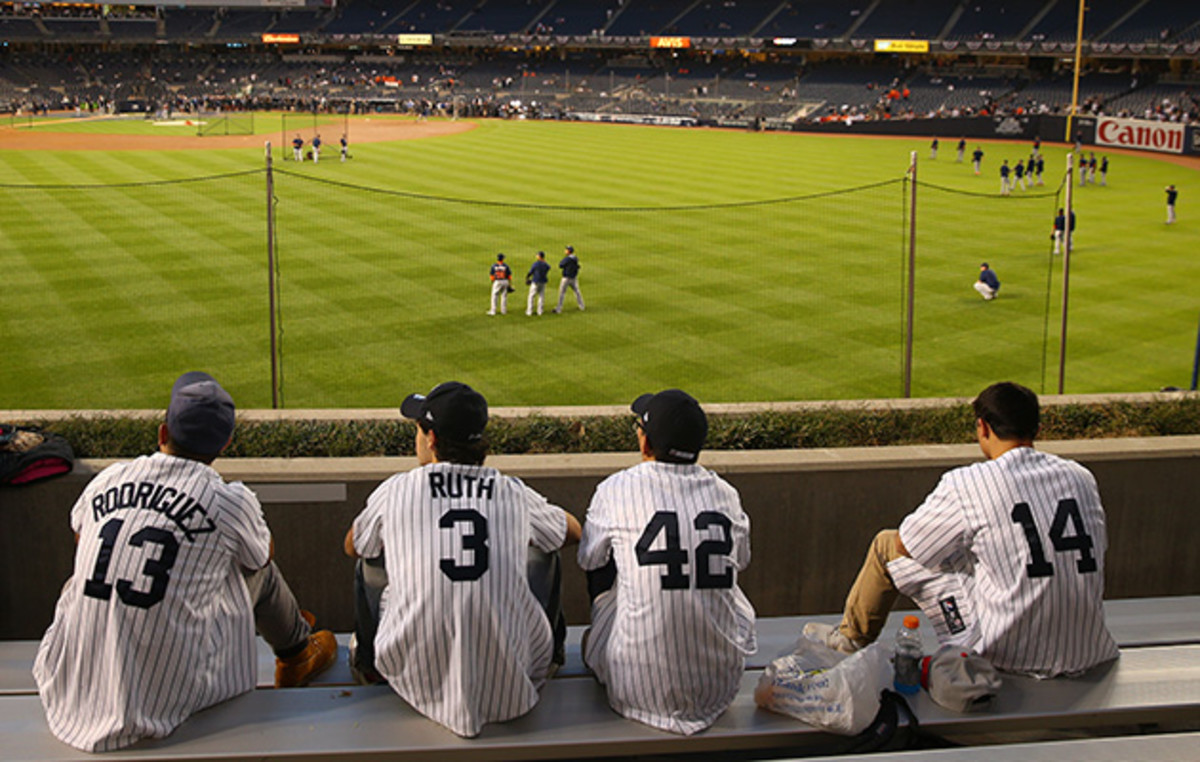
Manny Koenigsberg was born in Detroit in 1929 and while still a small child moved with his family to the Bronx, where the Koenigsbergs lived frugally in a small apartment while Manny’s father commuted to a job downtown in the garment industry. In ’51, Manny opened a small souvenir shop, Manny’s Baseball Land, on River Street, adjacent to Yankee Stadium. New Yorkers of a certain age (old) insist that Manny was the first to squint his eyes through the bustling haze of the present to the sports apparel merchandising future that lay ahead. He didn’t see clearly, but he saw something.
Caps, pennants and buttons had long been available at baseball stadiums. Koenigsberg provided those too. But through the 1960s he gradually expanded his inventory to include T-shirts and shiny jackets with the logos of major league teams. At one point he took a class at City College of New York that taught students how to run a mail-order business; his final project for that class became the first of many Manny’s Baseball Land catalogs, from which fans throughout the country could buy baseball gear. That mail-order business eventually delivered the bulk of the company’s revenues. Manny moved the store to New Jersey in 1978 and closed it for good in ’91.
Foot injury helped Peyton Manning make peace with himself, his new role
Now 86, Manny has resided in Las Vegas for nearly a quarter century. “I’m living the life of Riley from that little store,” he says. At the beginning, Manny recalls, he didn’t have a licensing agreement with Major League Baseball, but he did have numerous suppliers who could provide him with embroidered logos, which he would affix to pre-ordered jackets. “Somebody would come in and say they want a certain team. We’d take the jacket in the back, sew it up. My father worked back there for me [stitching].” At the peak of that product’s popularity, Manny says he was approached by members of Frank Sinatra’s entourage and asked to make Yankees jackets for Sinatra and sidekick Jilly Rizzo.
It’s impossible to say with certainty that Manny was the first retailer to seize on the connection between fans and apparel; many ballparks were selling similar items to the public at the same time. But with the publication of his catalog he seems to have been the first to understand the potential breadth of the business.
Manny sold jerseys too. In 1965 you could buy “replicas of major league uniforms” from his catalog, in “washable baseball flannel.” There was a catch, though; the uniforms were available only in youth sizes. Manny saw something, but he didn’t see quite enough. That was coming.
*****
Photographs from sporting events over the years provide an intriguing yet tantalizingly incomplete timeline of spectator fashion norms. Almost any crowd shot captured prior to 1960 will show fans dressed in what would now be considered business attire: men in jackets and ties, often with fedoras; women in dresses. Throughout the ’60s and into the ’70s, this formality begins to disintegrate, in concert with the larger customs of society. The first jerseys begin to surface in the early ’70s. But many of these photographs are black-and-white, making it difficult to discern if the pictured football jerseys, in particular, are replicas, or if these are just high school and college players wearing their own game tops.
In Sports Illustrated’s photo archives, the first image I found that plainly captured a fan wearing a replica jersey was that of an Islanders fan sporting a blue team jersey at a game in 1975. Photos published recently in The New York Times, however, seem to depict replica jersey-wearing fans at a Canadiens Stanley Cup celebration in the spring of ’73.
Football proved harder to pin down. A wide crowd shot taken in 1975 by SI photographer Neil Liefer at Super Bowl IX, between the Steelers and Vikings, shows thousands of Pittsburgh fans behind the team’s bench. Not a single jersey is readily visible. But four years later, in the Steelers’ Super Bowl XIII victory over the Cowboys, a wide shot of Pittsburgh receiver John Stallworth running into the end zone captured what appears to be a young boy in the front row wearing Franco Harris’s number 32 and a grown man behind him wearing either Dwight White’s number 78 or John Banaszak’s number 76. Still, there are just two of them among thousands. Clearly, retail jerseys were available throughout the ’70’s, but not in significant numbers.
There were also at least two jerseys visible in 1970’s popular culture. On the NBC series McMillan and Wife, which ran from ’71 to ’77, actress Susan St. James wore a nightshirt that appeared to be an authentic 49ers jersey bearing receiver Gene Washington’s number 18. St. James, 69 and married since ’81 to former NBC president Dick Ebersol, says the jersey was her idea. “I was much younger than [co-star] Rock [Hudson] and I was supposed to be this young breath of fresh air,’’ she says. “The show was set in San Francisco, I was a huge sports fan, so I thought the jersey was perfect. We got it from the team. It was a real jersey. I picked number 18, but Gene wouldn’t let us put his name on the back. And I still have the jersey.”
Similarly, in the opening credits of The Mary Tyler Moore Show, which ran from 1970 to ’77 and was set in Minneapolis, Moore is shown washing her car in a plain purple number 10 jersey. As the Vikings’ quarterback throughout the ’60s and ’70s, Fran Tarkenton wore number 10.
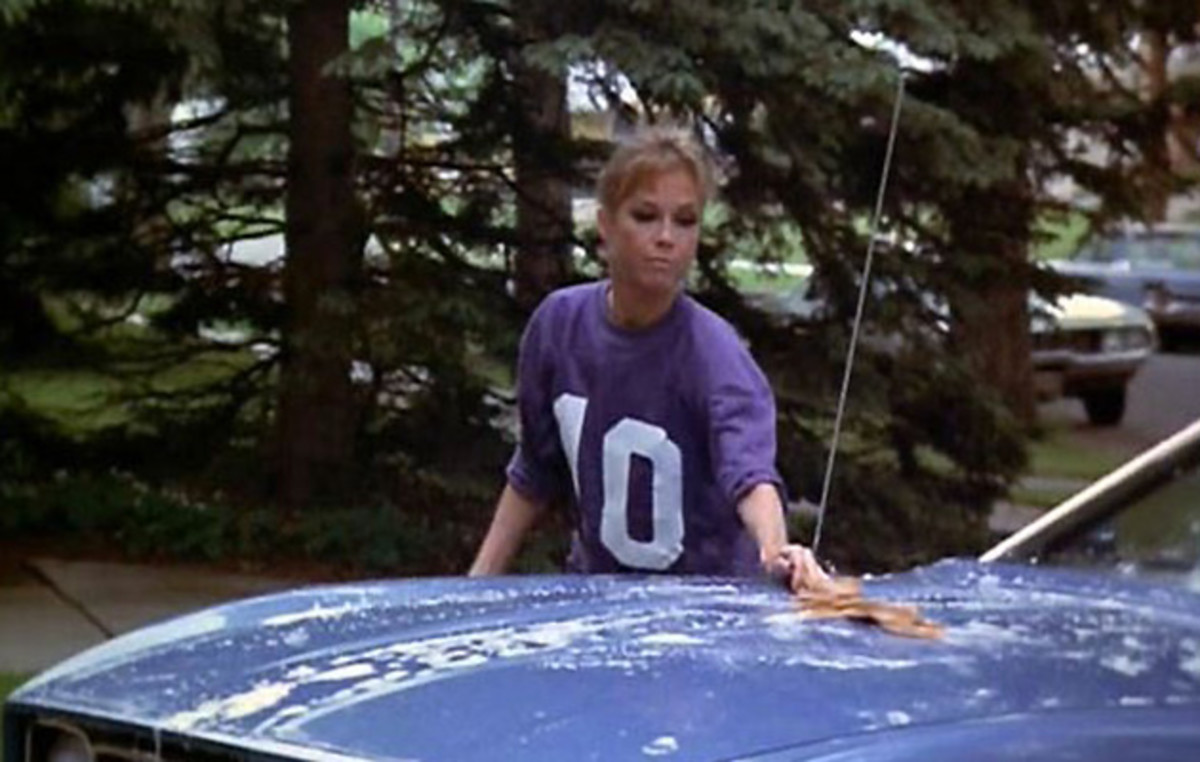
But how were these jerseys available to the general public, and who was the marketing genius that conceived of selling them? In multiple ways, most came from far outside the tight boundaries that exist in today’s licensed world. NFL Properties was formed in 1963, MLB Properties in ’66, NHL in ’69 and NBA in ’82—all with the purpose of collecting royalties from licensed products. But none of those leagues appears to have anticipated or specifically policed the jersey market until much later. Through much of the ’70s and ’80s, that business was largely an unregulated free-for-all.
One avenue toward obtaining a jersey was wholly organic: Local sporting goods shops across America—in the pre-big box store and pre-Internet era—were the primary provider of uniforms and gear to local high schools. These shops also had the materials to jury-rig “replica” jerseys at any customer’s asking. Dick Meldrim, now 61, was raised in Central New York and in the 1970s worked behind the counter at Cullen’s Sporting Goods in Cortland, N.Y. “People would come in and ask, ‘Can you get me a Yankees shirt?’” says Meldrim, who went on to a long career as a sales rep. “I’d find a company that made a white-and-blue pinstriped jersey, stick a Yankees logo on the front—‘There you go. Twenty-five bucks.’ It wasn’t licensed or official, but it was a Yankees’ jersey.”
The process that helped render this instant jersey-making feasible for small shops was invented in the early 1970s by the St. Louis-based Liebe Company, long famous for its meticulous sewn-on uniform logos, such as the Cardinals’ iconic birds-on-a-bat number. Fred Zappia, a sporting goods dealer who started his career with a small store in Endicott, N.Y., remembers using the company to pull off replicas: “I would buy blank jerseys and send them to Liebe for lettering. Or somebody would ask me for an Ernie Davis Syracuse football jersey; I would find a jersey with the right color and stripes, buy the number 44 from Liebe and give it to a local gal for sewing.”
That process became even easier in the early 1970s when Jim Liebe created a process called Vinflex, the precursor to all forms of heat-transfer lettering. Suddenly lettering was more accessible to the masses; Vinflex required less time—and skill—than sewing on three-color numbers.
Around this time, a Wisconsin company called Sand-Knit was providing jerseys in multiple sports not only to hundreds of local sporting goods dealers, but also to many professional and college teams. Hank Derleth, now 77, was the president of Sand-Knit in the late 1960s and early ’70s. (The company was sold to McGregor in ’74.) “A lot of NFL uniforms were pretty generic looking,” says Derleth. “Somebody could order, say, 40 red jerseys with yellow and white stripes and the manufacturer assumes they’re going to a high school team. But instead the guy puts numbers and names on them and sells them as retail [Chiefs] jerseys. There was no NFL shield, no team logo. Those things came later, and that’s when the NFL started cracking down it.”
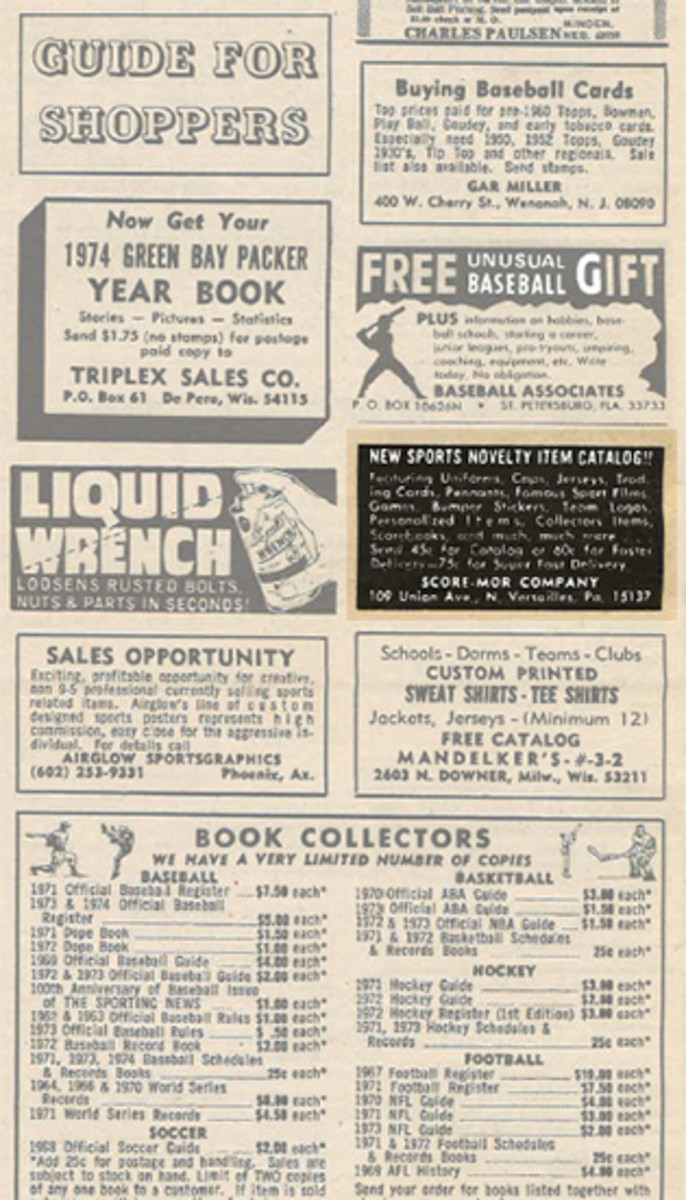
All together, this wide-open system was ideal for any number of enterprising individuals—perhaps people like Dan McKernan. In the early 1970s, The Sporting News carried a small display ad that shouted, New sports novelty item catalog! Featuring uniforms, caps, jerseys ... At the bottom of the ad was listed: Score-more company in North Versailles, Penn. According to state records, the Score-Mor Company was registered on April 19, 1972, by Daniel T. McKernan. A man by that name died at the age of 59 near North Versailles in 2010, which means that he would have opened Score-Mor at age 21. His obituary in the Pittsburgh Tribune lists him as the only child of Thomas and Florence Andrews McKernan, both deceased. His only survivors were described as “his friends, Rise and Leonard Chontos, with whom he resided.” I found Rise (REE-suh) Chontos through publicity for her feline rescue business, In Care of Cats.
In an email, Chontos described Dan McKernan: “I met Dan when he was 35 … He was alone, and not fully mentally equipped to handle life on his own … The one thing Dan really knew, inside out, was baseball. He breathed it. It was an amazement. He had boxes full of paraphernalia and he seemed very interested in business. As slow as he seemed, childlike, he was extremely sharp in some areas.” It’s not fully clear that the late Dan McKernan sold replica apparel, but his Sporting News ad makes it clear that he sold uniforms and jerseys. Like Manny Koenigsberg, McKernan saw something and acted upon it.
There was also a more mainstream pathway to our current jersey onslaught. In the days before giant shoe and apparel companies like Nike and Reebok became the officially licensed uniform suppliers for various sports leagues, many professional teams bought their game jerseys from local sporting goods dealers. Cosby Sports in New York, for example, served as the middleman in supplying the Giants, Jets, Knicks, Islanders and Rangers. Cosby would purchase uniforms from manufacturers and deliver them to teams. In the late 1960s and early ’70s, Cosby began purchasing extra jerseys with its standard team orders, and also sticking a lower-quality version of the same jerseys (those that would come to be called replica jerseys). “There was a revolving door of suppliers,” says Jim Root, who has worked for Cosby Sports since ’76, “but we always had some jerseys on the racks, and they always sold.” The young Islanders fan photographed by SI in ’75 almost certainly bought his jersey at Cosby’s.
• MORE: We still are not giving Steph Curry his due
Just to the south, another business plan serendipitously took hold. In 1972, Peter Capolino had taken ownership of Philadelphia sporting good store Mitchell & Ness from his father, Sisto. This was more than a decade before Capolino would—in what he calls his business “epiphany”—begin using old flannel to re-create vintage baseball jerseys, the foundation of a cultural and economic phenomenon that enabled Capolino to sell his business to adidas for millions. In ’72, Capolino was fighting to stave off bankruptcy, and noticed the Miami Dolphins—who would go unbeaten that year—wearing unusual teal-colored mesh jerseys on the road. The jerseys were made by Russell Athletic Company, who also supplied Capolino with many of the jerseys he sold to local high schools and colleges. “I wondered if I could just make Miami Dolphins jerseys, with numbers, and just not put their names on the back,” says Capolino. “So I would order 72 or 144 of that color jersey from Russell, with a lot of duplicate numbers. I guess they just saw them as team orders. Then we started doing other NFL teams, without the names. They flew out the door. I figured people were wearing them for touch-tackle games in the street. Maybe they started wearing them to games. I don’t know. They sure do now.”
*****
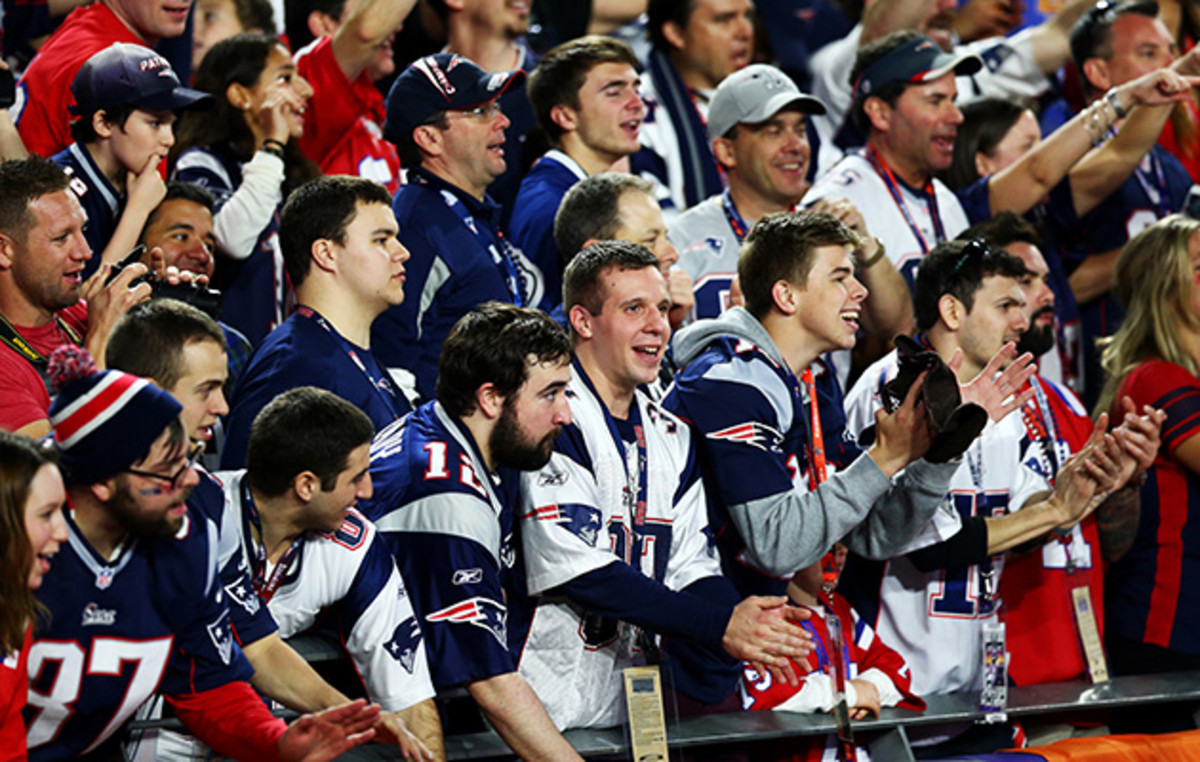
Why do we wear jerseys to watch others play games in jerseys? There’s a complex answer, first validated in a 1976 Arizona State study, performed by Robert Cialdini and five colleagues, that coined the acronym B.I.R.G. (Basking in Reflected Glory) by establishing that college students showed a greater tendency to wear school apparel (and use the pronoun “we”) after ASU’s football team had won than after it had lost. This concept goes further. “People have a need to belong and we want others to know that we belong,” says Dan Wann, a Murray State professor of psychology who has studied fan behavior. “But we also have the need for distinction, so you personalize your Royals jersey.”
Eric Simons, author of The Secret Lives of Sports Fans, says, “Humans don’t change. The culture changes. Clearly, jerseys are something that would have been desirable long before they were actually available.” Here, Fred Zappia, the upstate New York retailer, points to the surge in casual athletic clothing through the 1970s, propelled by the U.S. emergence of German shoemaker Adidas, and later Nike, as a subsequent factor in getting civilians into athletic wear for sporting events, much like those companies replaced the shoes on America’s feet with sneakers.
There’s also a far simpler reason for wearing jerseys: They’re cool. In a jersey, we are all Malcolm Butler, undercutting Ricardo Lockette and nailing down the Super Bowl. The jersey is Superman’s cape.
There are two potential visionaries in all of this, each of whom rode a wave that was partly of his own making and partly formed far outside of his vision. One was David Beckerman, who in 1971 founded Starter Clothing, primarily to service the uniform needs of schools in southern Connecticut, where Beckerman had gone to college. His most popular product was a satin windbreaker. “Very simple item,” says Beckerman. “Something for a softball team with Joe’s Bar and Grill on the back.” That product would explode into the immensely popular Starter Jackets of the 1980s: Beckerman was granted a non-exclusive license from Major League Baseball in ’76 and, after years of visiting their offices—“bringing coffee to the receptionist every time,” says Beckerman—from the NFL in 1982. Starter jackets and caps crossed into popular culture and made Beckerman wealthy. His company was not, however, primarily a jersey-maker. Jerseys did not send his company soaring. Jackets and hats did that.
The other visionary, Canadian-born Norm Charney, was working as an accountant in Dallas in 1981 when he purchased Athletic Supply, a local sporting goods store that fed uniforms and equipment to local schools and, more importantly, to the Cowboys. “Every year we would refurbish the Cowboys’ helmets,” says Charney, “and before each season we’d put them on display in the store. People would come in and just ooh and ahh over those helmets. So I told the staff to start putting some game jerseys on display, and people loved those too.”
Rodger Bruce, one of Charney’s employees at the time, recalls Charney asking, “‘Why can’t we sell those jerseys—the real thing?’ I told him that would be illegal. NFL Properties was still a pretty minor operation, but they had issued some licenses for replica clothing by then. Norm said, ‘Go ahead and sell ’em,’ and sure enough, we got a visit from two guys from the NFL. They looked like they were from the FBI.”
Informed that he didn’t have the authority to sell jerseys, Charney went to New York, met with the league and was granted a license to sell authentic merchandise. By 1985, he was selling authentic NFL game jerseys—“tens of thousands of them,” he says—through his NFL Pro Shop catalog. Since the NFL didn’t yet have a single jersey manufacturer, Charney struck deals with the various companies—Sand-Knit and Starter among them—to distribute, and he built a warehouse with a sewing shop and heat press. Within a few years he also had deals with Major League Baseball, the NBA, NHL and NASCAR. After consolidating all of the leagues into his own Athletic Supply Catalog, he sold the company in ’95. “I was in the right place at the right time,” says Charney. “But I can’t say I saw jerseys growing into the multi-billion dollar business that it is today.”
• MORE: Super Bowl can make or break career for little-known players
Ultimately, exclusive uniform deals took the jersey market entirely out of the hands of third-party vendors. In 2001, the NFL made Reebok its first official jersey maker. Four years later, Majestic became the exclusive supplier of MLB uniforms. The NHL paired up with The Hockey Company, which was bought by Reebok. (The NBA was the only outlier, having first signed up exclusively with Sand-Knit in 1967.) Once exclusivity was in place, the entire operation shifted to stadium stores, big box retailers and, eventually, the Internet. Swiftly it exploded into the modern-day juggernaut, servicing fans who will pay more than $300 for a jersey in which they will not play sports.
But whither the distant outfit that provided the jerseys of my youth, the SCORE-LINEUP CO. of Spokane, Wash., so far ahead of its time, so prescient? Did its founders know that people would someday stream into stadiums wearing game gear? Or did they, like Peter Capolino of Mitchell & Ness, simply think that we might wear these jerseys playing games of our own?
Alas, the company proved elusive. Men with decades-deep roots in the Eastern Washington sporting goods scene could not recall any such a business. Their consensus: The SCORE-LINEUP CO. was probably just one man heat-pressing numbers onto jerseys in his basement or garage. The branch manager of the Spokane post office holding the P.O. box that SCORE-LINEUP listed in its ad four decades ago has records dating back only seven years; none of his older employees could remember anyone hauling boxes of jerseys to the front window and shipping them to hungry kids like me so long ago—though someone clearly did. That person’s identity is apparently lost to the ether of time, preserved only on the yellowed pages of an old newspaper.
